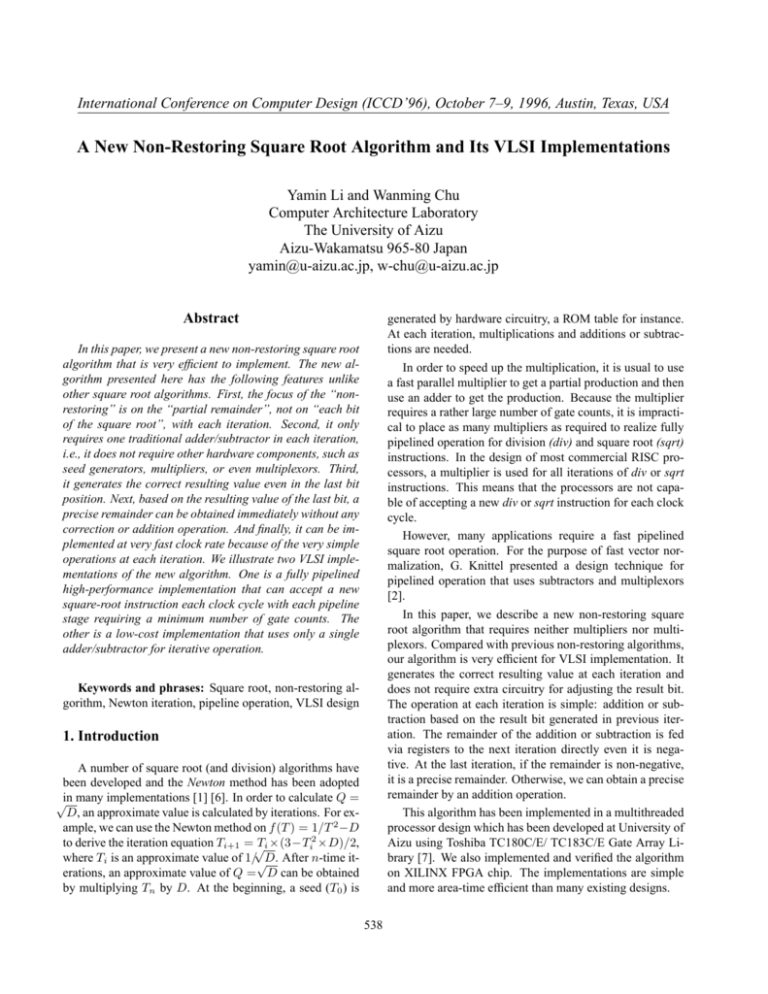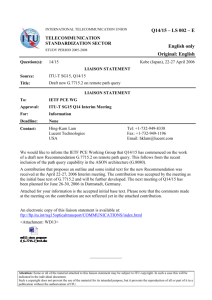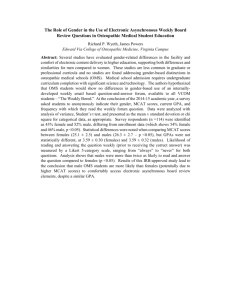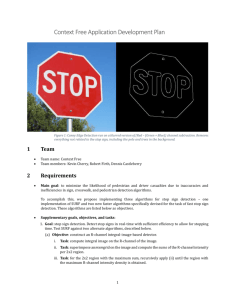A New Non-Restoring Square Root Algorithm and Its
advertisement

International Conference on Computer Design (ICCD’96), October 7–9, 1996, Austin, Texas, USA
A New Non-Restoring Square Root Algorithm and Its VLSI Implementations
Yamin Li and Wanming Chu
Computer Architecture Laboratory
The University of Aizu
Aizu-Wakamatsu 965-80 Japan
yamin@u-aizu.ac.jp, w-chu@u-aizu.ac.jp
Abstract
generated by hardware circuitry, a ROM table for instance.
At each iteration, multiplications and additions or subtractions are needed.
In order to speed up the multiplication, it is usual to use
a fast parallel multiplier to get a partial production and then
use an adder to get the production. Because the multiplier
requires a rather large number of gate counts, it is impractical to place as many multipliers as required to realize fully
pipelined operation for division (div) and square root (sqrt)
instructions. In the design of most commercial RISC processors, a multiplier is used for all iterations of div or sqrt
instructions. This means that the processors are not capable of accepting a new div or sqrt instruction for each clock
cycle.
However, many applications require a fast pipelined
square root operation. For the purpose of fast vector normalization, G. Knittel presented a design technique for
pipelined operation that uses subtractors and multiplexors
[2].
In this paper, we describe a new non-restoring square
root algorithm that requires neither multipliers nor multiplexors. Compared with previous non-restoring algorithms,
our algorithm is very efficient for VLSI implementation. It
generates the correct resulting value at each iteration and
does not require extra circuitry for adjusting the result bit.
The operation at each iteration is simple: addition or subtraction based on the result bit generated in previous iteration. The remainder of the addition or subtraction is fed
via registers to the next iteration directly even it is negative. At the last iteration, if the remainder is non-negative,
it is a precise remainder. Otherwise, we can obtain a precise
remainder by an addition operation.
This algorithm has been implemented in a multithreaded
processor design which has been developed at University of
Aizu using Toshiba TC180C/E/ TC183C/E Gate Array Library [7]. We also implemented and verified the algorithm
on XILINX FPGA chip. The implementations are simple
and more area-time efficient than many existing designs.
In this paper, we present a new non-restoring square root
algorithm that is very efficient to implement. The new algorithm presented here has the following features unlike
other square root algorithms. First, the focus of the “nonrestoring” is on the “partial remainder”, not on “each bit
of the square root”, with each iteration. Second, it only
requires one traditional adder/subtractor in each iteration,
i.e., it does not require other hardware components, such as
seed generators, multipliers, or even multiplexors. Third,
it generates the correct resulting value even in the last bit
position. Next, based on the resulting value of the last bit, a
precise remainder can be obtained immediately without any
correction or addition operation. And finally, it can be implemented at very fast clock rate because of the very simple
operations at each iteration. We illustrate two VLSI implementations of the new algorithm. One is a fully pipelined
high-performance implementation that can accept a new
square-root instruction each clock cycle with each pipeline
stage requiring a minimum number of gate counts. The
other is a low-cost implementation that uses only a single
adder/subtractor for iterative operation.
Keywords and phrases: Square root, non-restoring algorithm, Newton iteration, pipeline operation, VLSI design
1. Introduction
A number of square root (and division) algorithms have
been developed and the Newton method has been adopted
√in many implementations [1] [6]. In order to calculate Q =
D, an approximate value is calculated by iterations. For example, we can use the Newton method on f (T ) = 1/T 2 −D
to derive the iteration equation Ti+1 = √
Ti ×(3−Ti2 ×D)/2,
where Ti is an approximate value of 1/√D. After n-time iterations, an approximate value of Q = D can be obtained
by multiplying Tn by D. At the beginning, a seed (T0 ) is
538
D = 01,11,11,11
Q = 1000 D - Q
+ 0100
Q = 1100 D - Q
- 0010
Q = 1010 D - Q
+ 0001
Q = 1011 D - Q
The paper is organized as follows. Section 2 describes
previous non-restoring square root algorithms. Section 3
gives our new non-restoring square root algorithm. Section
4 and 5 introduce two VLSI implementations for the new
algorithm. One is a fully pipelined implementation and the
other is a low-cost implementation. The following section
investigates the performance and cost compared with the
Newton iteration algorithm. The final section presents conclusions.
x Q = 00,11,11,11 is nonnegtive
x Q = 11,10,11,11 is negtive
x Q = 00,01,10,11 is nonnegtive
x Q = 00,00,01,10
Figure 2. An example of previous nonrestoring square root algorithm
2. Previous Non-Restoring Square Root Algorithm
3. The New Non-Restoring Square Root Algorithm
Assume that an operand is denoted by a 32-bit unsigned
number: D = D31 D30 D29 ...D1 D0 . The value of the
operand is D31 × 231 + D30 × 230 + D29 × 229 + ...D1 ×
21 + D0 × 20 . For every pair of bits of the operand, the
integer part of square root has one bit (see Fig. 1). Thus the
integer part of square root for a 32-bit operand has 16 bits:
Q = Q15 Q14 Q13 ...Q1 Q0 .
OPERAND
SQUARE
ROOT
D31 D 30 D 29 D 28 D27 D 26
...
D1 D 0
Q 14
...
Q0
Q15
Q 13
The focus of the previous restoring and non-restoring algorithms is on each bit of the square root with each iteration. In this section, we describe a new non-restoring square
root algorithm. The focus of the new algorithm is on the
partial remainder with each iteration. The algorithm generates a correct resulting bit in each iteration including the last
iteration. The operation during each iteration is very simple: addition or subtraction based on the sign of the result
of previous iteration. The partial remainder generated in
each iteration is used in the next iteration even it is negative
(this is what non-restoring means in our new algorithm). At
the final iteration, if the partial remainder is not negative,
it becomes the final precise remainder. Otherwise, we can
get the final precise remainder by an addition to the partial
remainder.
The following is the new non-restoring square root algorithm written in the C language.
Figure 1. Format of operand and square root
At first, we reset Q = 0 and then iterate from k = 15 to
0. In each iteration, we set Qk = 1, and subtract Q×Q from
D. If the result is negative, then setting Qk made Q too big,
so we reset Qk = 0. This algorithm modifies each bit of Q
twice. This is called a restoring square root algorithm. An
implementation example can be found in [5].
A non-restoring square root algorithm modifies each bit
of Q once rather than twice. It begins with an initial guess
of Q = Q15 Q14 Q13 ...Q1 Q0 = 100...00 (partial root) and
then iterates from k = 14 to 0. In each iteration, D is subtracted by the squared partial root: D − Q × Q. Based on
the sign of the result, the algorithm adds or subtracts a 1 in
Qk position. An 8-bit example of the algorithm is shown in
Fig. 2. Implementation examples can be found in [3] and
[4].
We can see that the algorithm has following disadvantages. First, it requires an addition/subtraction (increase/decrease) operation to get a resulting bit value. Second, the algorithm may produce an error in the last bit position. Third, it requires an operation of D − Q × Q at each
iteration with the result not being used for the next iteration. Although the multiplication of Q × Q can be replaced
by substitute variable, the circuitry required is still complex.
unsigned squart(D, r) /*Non-Restoring sqrt*/
unsigned D;
/*D:32-bit unsigned integer
to be square rooted */
int
*r;
{
unsigned Q=0; /*Q:16-bit unsigned integer
(root)*/
int R=0; /*R:17-bit integer (remainder)*/
int i;
for (i=15;i>=0;i--) /*for each root bit*/
{
if (R>=0)
{
/*new remainder:*/
R=(R<<2)|((D>>(i+i))&3);
R=R-((Q<<2)|1);
/*-Q01*/
}
else
{
/*new remainder:*/
R=(R<<2)|((D>>(i+i))&3);
539
R=R+((Q<<2)|3);
}
if (R>=0) Q=(Q<<1)|1;
else
Q=(Q<<1)|0;
Q15 +Q14 ) = 4×Q15 ×Q15 +4×Q15 ×Q14 +Q14 ×Q14 and
15 15
15 15
R31
R30 D29 D28 = 4×R31
R30 +D29 D28 = 4×(D31 D30 −
Q15 ×Q15 )+D29 D28 = D31 D30 D29 D28 −4×Q15 ×Q15 ,
we can get Equation 2 from Equation 1:
/*+Q11*/
/*new Q:*/
/*new Q:*/
}
15 15
R31
R30 D29 D28 ≥ 4 × Q15 × Q14 + Q14 × Q14 .
/*remainder adjusting*/
if (R<0) R= R+((Q<<1)|1);
*r=R;
/*return remainder*/
return(Q);
/*return root*/
If we assume Q14 = 1, the Equation 2 turns into
15 15
R31
R30 D29 D28 ≥ 4 × Q15 + 1.
}
An 8-bit numerical example is given in Fig. 3. For good
readable, some high order remainder bits are also shown,
but they are not needed. It is sufficient for the remainder to
have at most one bit more than the root.
D = 01,11,11,11
R = 01
- 01
R = 00,11
- 01,01
R = 11,10,11
+ 00,10,11
R = 00,01,10,11
- 00,01,01,01
R = 00,00,01,10
R=0
Q=0000
R: nonnegative
Q=0001
R: nonnegative
Q=0010
R: negative
Q=0101
R: nonnegative
Q=1011
R: nonnegative
(3)
The value of right side of Equation 3 is Q15 01. If the
15 15
result of R31
R30 D29 D28 − Q15 01 is negative, then Q14 =
0, i.e., q14 = Q15 0, otherwise Q14 = 1, i.e., q14 = Q15 1.
14 14 14
And we will have a new remainder: r14 = R30
R29 R28 =
15 15
R31 R30 D29 D28 − 4 × Q15 × Q14 + Q14 × Q14 , i.e., if
15
D29 D28 is
Q14 = 0, the remainder is left unchanged; R30
just bypassed.
In a VLSI implementation, a multiplexor can perform
the selection of the unchanged remainder or the changed
remainder generated by subtractor (See Fig. 4).
(-Q01)
(-Q01)
(+Q11)
(-Q01)
q15 = Q15
Q15
15 15
r15 = R31
R30
15
R15
31 R30 D29 D28
Figure 3. An example of Non-Restoring
Square Root
0
0
1
SUB4
Before we explain the reason of why the algorithm
works, we will describe a restoring square root algorithm
that also uses the partial remainder for the next iteration.
√
For the D = D31 D30 D29 ...D1 D0 and Q = D =
Q15 Q14 Q13 ...Q1 Q0 , we start the calculation with the most
significant pair (D31 D30 ) of D. There are four possible values: 00, 01, 10, and 11. The integer part of the square root
(Q15 ) will be 0 (for 00) or 1 (for 01, 10, and 11). In general,
we can determine the Q15 by subtracting 01 from D31 D30 .
If the result is negative, then Q15 = 0, otherwise Q15 = 1.
By subtracting Q15 × Q15 from D31 D30 , we can get the
15 15
partial remainder r15 = R31
R30 = D31 D30 − Q15 × Q15 .
15 15
Here, the 15 in R31 R30 means that the remainder is for the
square root bit Q15 . The possible values of the remainder
include 00, 01, and 10. We also use qk to denote the partial
root obtained at iteration k: qk = Q15 Q14 ...Qk .
Now, consider the next pair (D29 D28 ). The new partial
15 15
remainder is r15 D29 D28 = R31
R30 D29 D28 . The present
task is to find the Q14 so that the partial root q14 = Q15 Q14
is the integer part of the square root for D31 D30 D29 D28 .
We have Equation 1:
D31 D30 D29 D28 ≥ (Q15 Q14 ) × (Q15 Q14 ).
(2)
MSB
MUX
Q15 Q14
q14 = Q15 Q14
14 14 14
R30
R29 R28
14 14 14
r14 = R30
R29 R28
Figure 4. A multiplexor for restoring algorithm
14
Note that the R31
is always 0. The reason is as follows. If
we assume T is the integer part of the square root of operand
S, then we have the equation S = (T × T + R) < (T +
1) × (T + 1) where R is the remainder. Thus, R < (T +
1) × (T + 1) − T × T = 2 × T + 1, i.e., R ≤ 2 × T because
the remainder R is an integer. It means that the remainder
has at most one binary bit more than the square root.
For clarity, we will demonstrate the calculation of the
next square root bit, Q13 . Consider the new pair (D27 D26 ),
(1)
Since (Q15 Q14 ) × (Q15 Q14 ) = (2 × Q15 + Q14 ) × (2 ×
540
14 14 14
we get the new remainder: R30
R29 R28 D27 D26 . Similarly,
we have
D31 D30 D29 D28 D27 D26 ≥ (Q15 Q14 Q13 ) × (Q15 Q14 Q13 ).
(4)
Since (Q15 Q14 Q13 ) × (Q15 Q14 Q13 ) = (2 × Q15 Q14 +
Q13 ) × (2 × Q15 Q14 + Q13 ) = 4 × Q15 Q14 × Q15 Q14
14 14 14
+4 × Q15 Q14 × Q13 + Q13 × Q13 and R30
R29 R28 D27 D26
= D31 D30 D29 D28 D27 D26 − 4 × Q15 Q14 × Q15 Q14 , we
can get Equation 5:
where rk ab is the previous remainder passed via multiplexor. Referring to Equation 8, we can re-write Equation 12 as following.
rk−2 = rk−1 cd + qk 0100 − qk−1 01.
Referring to Equation 11, we can re-write Equation 13 as
following.
rk−2 = rk−1 cd + qk−1 100 − qk−1 01.
rk−2 = rk−1 cd + qk−1 11.
14 14 14
R30
R29 R28 D27 D26 ≥ 4 × Q15 Q14 + 1 = Q15 Q14 01.
(6)
14 14 14
R29 R28 D27 D26 − Q15 Q14 01 is
Also, Q13 = 0 if R30
negative and Q13 = 1 otherwise. The remainder r13 =
13 13 13 13
R29
R28 R27 R26 will be unchanged when Q13 = 0, or r13 =
13 13 13 13
14 14 14
R29
R28 R27 R26 = R30
R29 R28 D27 D26 − Q15 Q14 01 when
13
is always 0. We got q13 =
Q13 = 1. Also note that R30
Q15 Q14 Q13 .
We can repeat this calculation until the q0 =
Q15 Q14 ...Q0 is calculated. We can now explain why the
non-restoring algorithm works. Let qk be the partial square
root and rk ab be the partial remainder at step k where ab is
the next pair of operand and a = D2×k−1 and b = D2×k−2 .
The algorithm computes
q15 = Q15
Q15
15 15
r15 = R31
R30
15
R15
31 R30 D29 D28
SUB
rk−1 cd = 4 × rk−1 + cd
= 4 × (rk ab − qk 01) + cd
q14 = Q15 Q14
(8)
(9)
rk−2 = rk−1 cd − qk−1 01.
(10)
14 14 14
R30
R29 R28
14 14 14
r14 = R30
R29 R28
Figure 5. No multiplexor needed for nonrestoring algorithm
If rk−1 is not negative, the algorithm is the same as the
restoring algorithm:
qk−1 = 2 × qk + 1 = qk 1,
ADD/SUB4
MSB
Q15 Q14
Non-restoring in the previous algorithm means that the
bit of the partial root is set one time, and then, based on the
sign of D − Q × Q, the partial root is adjusted by adding
or subtracting a 1 in the corresponding position. However,
non-restoring in our algorithm means that the remainder in
each iteration is used for next iteration even if it is negative.
Thus, the remainder is not restored by using the previous
remainder as is done in the restoring algorithm via a multiplexor. In this sense, our non-restoring square root algorithm is very similar to the non-restoring division algorithm
[1].
But if rk−1 is negative, both the algorithms (restoring and
non-restoring) compute
(11)
while the restoring algorithm computes
rk−2 = rk abcd − qk−1 01,
1
(7)
if the sign of the previous result is not negative. The new
partial remainder is rk−1 cd where cd is the next pair of
operands and c = D2×(k−1)−1 and d = D2×(k−1)−2 , i.e.,
the new remainder
qk−1 = 2 × qk + 0 = qk 0,
(15)
Equation 15 is just what the non-restoring algorithm does.
In the VLSI implementation, only a single traditional
adder/subtractor is required to generate a partial remainder and a bit value of partial root. The least significant bit
(LSB) of the partial root is used for controlling the operation of adder/subtractors. If the LSB of partial root is 1, the
adder/subtractor subtracts Q01 from R; if LSB of partial
root is 0, the adder/subtractor adds Q11 to R. Therefore,
the second least significant bit is just the inverse of the LSB
of partial root (See Fig. 5).
0
= rk abcd − qk 0100.
(14)
Because qk−1 100 − qk−1 01 = (8 × qk−1 + 100) − (4 ×
qk−1 + 01) = 4 × qk−1 + 11 = qk−1 11, we get
14 14 14
R30
R29 R28 D27 D26 ≥ 4 × Q15 Q14 × Q13 + Q13 × Q13 .
(5)
Again, if we assume Q13 = 1, the Equation 5 turns into
rk−1 = rk ab − qk 01
(13)
(12)
541
Table 1. Operation of first stage
D31-0
Input
D31 D30
0
0
0
1
1
0
1
1
D31-30
0
1
SUB
001
3
2
MSB
Q15
R31-30
Q15
0
1
1
1
Output
R31 R30
1
1
0
0
0
1
1
0
D29-0
D31-0
D29-28
D31
0
SUB
Q14
D30
4
D29-28
0
3
MSB
Q15
1
R30-28
SUB
D27-0
MSB
D27-26
D25-0
4. VLSI Design of Fully Pipelined Version
D25-24
0
MSB
Q15-13
Q12
...
Q15-2
Q1
1
The pipelined circuitry for a 32 bit unsigned number is
shown in Fig. 6. There are 16 adder/subtractors. The numbers of bits for these adder/subtractors are 3, 4, 5, 6, ..., 18.
The gate count required is reduced because no multiplexor
is needed.
Furthermore, based on Table 1, we can merge the first
two steps into one step (see Fig. 7) with the following expressions.
6
5
R28-24
D23-0
...
...
R17-2
D1-0
Q15 = D31 ∨ D30 ,
R31 = D31 ⊕ D30 ,
R30 = D30 .
D1-0
0
SUB
MSB
Q15-1
Q0
D27-0
Figure 7. Simplification of the first two steps
4
R29-26
SUB
R30-28
...
Q13
3
5
MSB
Q15-14
Q14
4
...
SUB
Q15
1
...
0
1
1
Such fully pipelined circuitry can initiate a new sqrt instruction with each clock cycle.
18
5. VLSI Design of Iterative Version
17
An iterative low-cost version of the VLSI design for 32bit operands is shown in Fig. 8. The 32-bit operand is placed
in register D and it will be shifted two bits left in each iteration. Register Q holds the square root result and it is
initialized to zero at the beginning. It will be shifted one
R16-0
Figure 6. Non-restoring square root pipeline
542
bit left in each iteration. Register R contains the partial remainder. It is cleared at the beginning in order to start the
first iteration properly.
D
31
..
29
30
28
3
..
be generated by Newton iteration two times for D =
D31 D31 ...D1 D0 and Q = Q15 Q14 ...Q1 Q0 by Equation 16:
Ti+1 = Ti × (3 − Ti2 × D)/2,
(16)
√
where Ti is an approximate value of 1/ D. At first, a seed
(T0 ) is generated by a ROM table. After two-time iterations,
the square root Q can be obtained by T2 × D (see Fig. 9).
1
2
0
Shift register
D
Shift register
Q
ROM
1
1716
..
3 2 1 0
/2
15 14 .. 1 0
1716 ..
MUX
3 2 1 0
Ti
1:+
0:-
ADD/SUB
18 BITS
MUX
1716 15 14 .. 1 0
MUX
Partial Product Generator
R
17 16 15 14 ..
1 0
A
B
3
MUX
Figure 8. Iteration of non-restoring square
root
MUX
ADD/SUB
A single adder/subtractor is required. It subtracts if the
control input is 0, otherwise it adds. One resulting bit is
generated in each clock cycle, and a total of 16 cycles is
needed to get the final square root. Such low-cost circuitry
can initiate a new sqrt instruction every 16 clock cycles.
Compared to [4], the simplicity of the circuitry for our new
algorithm can be readily appreciated.
C
Q
Figure 9. An implementation of Newton iteration
6. Performance and Cost Evaluation
Calculation time is measured by the number of clock cycles. We assume the time of a clock cycle t = tAS + tM X
where the tAS is the delay time of adder/subtractor and the
tM X is the delay time of the multiplexor. The cycle time
of the circuitry for the new non-restoring algorithm is less
than t because no multiplexor is used, i.e., t = tAS . Multiplication in Newton iteration takes two cycles: the partial
product is generated in the first cycle and the product is generated in the second cycle by the adder. We assume that par-
In this section, we discuss the performance and cost of
our algorithm compared with Newton iterative implementation. As mentioned in the introduction section, it is impractical to implement the fully pipelined version for Newton
iteration (if it is not impractical, at least it is high cost), we
only discuss on iterative implementations for both the algorithms.
√
D can
Consider that a correct result of Q =
543
tial product generation can be finished within the cycle time
t.
Fig. 9 shows a possible implementation at the above assumed cycle time t. Table 2 shows the sequence of Newton
iteration. This requires 17 cycles to get a square root, one
cycle more than our algorithm.
different types of instructions, there will be resource conflicts, and the processor will not be capable of exploiting
the instruction level parallelism very well. For example, if
a multiplier in a processor is shared by the mul, div, sqrt
instructions, it is impossible to issue these instructions in
parallel even if there is no data dependency. Therefore, it is
important for multiple-issued processors to have dedicated
functional units that can perform special operations independently of each other.
Table 2. Two-time Newton iterations for
square root calculation
Cycle
1
2
3
4
5
6
7
8
9
10
11
12
13
14
15
16
17
Calculation
T0
T02
T02
T02 D
T02 D
3 − T02 D
T0 (3 − T02 D)
(T0 (3 − T02 D))/2
T12
T12
T12 D
T12 D
3 − T12 D
T1 (3 − T12 D)
(T1 (3 − T12 D))/2
T2 D
T2 D
7. Conclusion
Operation
T0 = ROM [D]
A, B = P artial P rod.
C = A + B (Prod.)
A, B = P artial P rod.
C = A + B (Prod.)
C = 3 − T02 D
A, B = P artial P rod.
T1 = (A + B)/2 (Prod./2)
A, B = P artial P rod.
C = A + B (Prod.)
A, B = P artial P rod.
C = A + B (Prod.)
C = 3 − T12 D
A, B = P artial P rod.
T2 = (A + B)/2 (Prod./2)
A, B = P artial P rod.
C = A + B (Prod.)
A new non-restoring square root algorithm was presented in this paper. The algorithm is highly suitable for
VLSI designs and can exploit the advances in VLSI technology. Two VLSI implementations have illustrated the benefit
of the algorithm: high speed was achieved at minimum cost
because neither a multiplier nor a multiplexor is required.
References
[1] J. Hennessy and D. Patterson, Computer Architecture,
A Quantitative Approach, Second Edition, Morgan
Kaufmann Publishers, Inc., 1996.
[2] G. Knittel, “ A VLSI-Design for Fast Vector Normalization” Comput. & Graphics, Vol. 19, No. 2, 1995.
pp261 - 271.
[3] J. Bannur and A. Varma, “The VLSI Implementation
of A Square Root Algorithm”, Proc. IEEE Symposium on Computer Arithmetic, IEEE Computer Society Press, Washington D.C., 1985. pp159 - 165.
The contrast between cycles and gate counts of the two
algorithms is listed in Table 3. We find that the new algorithm requires fewer cycles when the bit width of operand
is 16 and 32, and the Newton method requires fewer cycles
when the bit width of the operand is 64. The obvious advantage of the new non-restoring algorithm is that only a
traditional adder/subtractor with few shift registers can perform square root operations efficiently.
[4] J. O’Leary, M. Leeser, J. Hickey, M. Aagaard, “NonRestoring Integer Square Root: A Case Study in Design by Principled Optimization”, Proc. 2nd International Conference on Theorem Provers in Circuit Design (TPCD94), 1994. pp52 - 71.
[5] K. C. Johnson, “Efficient Square Root Implementation on the 68000”, ACM Transaction on Mathematical Software, Vol. 13, No. 2, 1987. pp138 - 151.
Table 3. Required time and space contrast of
two implementations
Data Bits
Newton
Non-res.
No.
16
10
8
of Cycles
32 64
17 24
16 32
[6] H. Kabuo, T. Taniguchi, A. Miyoshi, H. Yamashita, M.
Urano, H. Edamatsu, S. Kuninobu, “Accurate Rounding Scheme for the Newton-Raphson Method Using
Redundant Binary Representation”, IEEE Transaction
on Computers, Vol. 43, No. 1, 1994. pp43 - 51.
No. of Gates
16
32
64
2,300 5,800 18,000
550 1,100
2,200
[7] Y. Li and W. Chu, “Design and Performance Analysis
of A Multiple-threaded Multiple-pipelined Architecture,” Proc. of the Second International Conference
on High Performance Computing, New Delhi, India,
December 1995. pp483 - 490.
It is clear that multiple functional units can be easily fabricated in a single chip processor with current VLSI technology. However, if some functional units, such as the
multiplier and adder/subtractor for instance, are shared by
544






